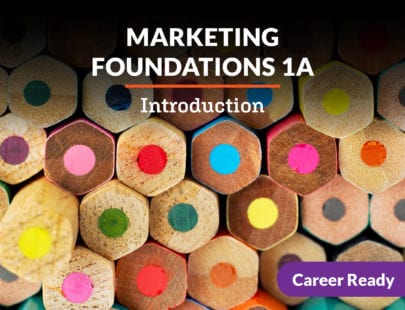
Marketing 2a: Global Business and Trade
Can you think of a brand that first launched in the U.S. and then became popular in other countries? Facebook™ did this very thing! Without a solid understanding of business and international marketing strategy, it becomes nearly impossible to be successful and stand out from the crowd. Discover how business and marketing works around the world. You’ll learn about topics such as regulations, market research, marketing plans, global trends, buying and selling internationally, and more.
Units at a Glance
Unit 1: The Business Environment
In 2004, Mark Zuckerberg spent a lot of time in his dorm room. The then-19-year-old lived in Room H33 at Harvard University’s Kirkland House, where he built the website that would eventually become Facebook. Within just two years of creating the site, Facebook had over 50 million users. A few years later, it had a billion users, making it the largest social networking site on the internet and one of the biggest companies in the world. But how did Facebook go from a dorm room at Harvard to becoming the company that it is now? Let’s find out!
What will you learn in this unit?
- Compare and contrast entrepreneurship and intrapreneurship
- Analyze advantages and disadvantages of business ownership
- Examine the four phases of the business cycle
- Describe the use of business ethics in promotion
Unit 2: Global Business Environment
In the past, shipping products from one location to another took days. Air travel wasn’t as efficient as it is now, and the main modes of transport were ships and trucks. Fast forward to today, and the world looks a lot different. You can now place an order for certain products on the internet and have them delivered the same day. You can go to your local grocery store and buy fresh fruits and vegetables that were not grown in your country. All of this is possible because of globalization. You might have heard that term before, but we’re about to explore what it really means for businesses and consumers. It’s a whole new world!
What will you learn in this unit?
- Discuss the global environment in which businesses operate
- Interpret labor issues associated with global trade
- Describe the determinants of exchange rates and their effects on the domestic economy
- Determine the impact of global trade on business decision making
Unit 3: Market Research in a Global
How do businesses know which products or services to create? What ads to use? or how much to charge customers? It may seem like a lot of guesswork is involved, but there’s a proven process behind this. It all comes down to market research. Most marketers overlook the importance of good research and jump straight into creating ads and other promotions without a solid understanding of the market. We’ll explain why that’s not such a great idea and what should be done instead. So let’s get started!
What will you learn in this unit?
- Explain the importance of marketing research
- Describe methods used to design marketing research studies
- Identify strategies for entering international markets
- Describe types of rating scales
Unit 4: Marketing Fundamentals Around the World
Marketing continues to change every day. Thanks to the internet, it’s now possible for brands to market their products and services to people around the world at a fraction of the cost of traditional advertising. Social media has also made it possible for regular people to start and launch successful businesses without having a website or storefront. Let’s find out how marketing works around the world!
What will you learn in this unit?
- Create a marketing plan
- Compare the benefits of various types of promotional media, including direct marketing, telemarketing, and social media
- Explain the role of marketing in a free enterprise system
- Examine the concept of promotional mix
Unit 5: Marketing Regulation
Picture this—you’re browsing through the internet and you see an ad for a brand-new iPhone. You’ve always wanted to get a new phone, and you’re excited by what you see. After clicking on the ad, you notice that phone is half the price of an original, brand-new phone. Without hesitation, you immediately click the Buy Now button and put in your information. A few days pass by and a box arrives at your front door. It’s your brand-new iPhone! You unwrap the box ready to discover all the cool new features you’ve heard about, but it doesn’t take long before you find out something isn’t quite right. You notice that the phone you got wasn’t the same model that was advertised in the ad. In fact, it’s not even an iPhone. What happened? It turns out you were a victim of an unethical marketing campaign. Luckily, there are marketing regulations to protect you from this exact scenario. Let’s explore them!
What will you learn in this unit?
- Describe the regulation of marketing information management
- Identify and explain personal and long-term consequences of unethical or illegal behaviors
- Determine unfair business practices
- Clarify how business is affected by government regulation of consumer protection
Unit 6: Products and Merchandising
The Rubik’s Cube is widely considered to be the best-selling toy of all time, with more than 350 million sold worldwide since its launch. It was created in 1974 by Erno Rubik as a tool to help students learn algebra but quickly grew into a worldwide phenomenon when an American toy manufacturer bought the product license and started selling it in the 1980s. With its iconic design, affordability, and level of difficulty, the Rubik’s cube continues to be a popular product today. The product also shows what’s possible when companies use the right merchandising and promotional techniques to reach customers. If you’ve ever wondered how businesses come up with new ideas for products in the first place, you’re about to find the answer. Get ready to discover the world of products and merchandising!
What will you learn in this unit?
- Examine the phases of the product life cycle
- Demonstrate the sales promotion technique of locating advertised merchandise on the selling floor
- Determine markups, markdowns, and break-even points
- Identify the psychological effects of pricing
Unit 7: Global Buying and Distribution
Take a trip to your local grocery store. Everything you see went through many distribution channels before getting to you. Some products were transported by trucks from your city’s local farm, while others took a long trip by plane from a continent thousands of miles away from you. You might not think much about it, but global buying and distribution has a big effect on how businesses operate today. As a marketer, you will be able to create better marketing campaigns by understanding everything that takes place from the moment a product is created to the time it’s delivered to customers. Ready to get a behind-the-scenes look at how all this works? We’re going to pull back the curtain and show you how it’s done!
What will you learn in this unit?
- Explain how goods and services are ordered
- Describe the ethical considerations in channel management
- Analyze import and export laws in relation to buying and selling products in an international market
- Outline the steps in a buying plan
Unit 8: International Marketing Trends
The world is more interconnected than ever before. What happens in one part of the globe has a rippling effect everywhere else. Competition is also at an all-time high. Businesses are no longer competing with other companies in their neighborhood—they’re competing with organizations from all parts of the world. Without a solid international marketing strategy, it becomes nearly impossible to stand out from the crowd. That’s why looking at trends is key. By knowing how things are changing, businesses can stay one step ahead of the competition and continuously innovate their products and services. There are many trends that influence international marketing, but you’re about to discover the most significant ones.
What will you learn in this unit?
- Analyze current trends in marketing
- Explain economic trends related to marketing
- Compare and contrast global marketing trends
Required Materials
Computer with:
- Internet access
- Word processing program
- Slideshow presentation program
- Camera for still photographs (either digital or cell phone camera)
- Video recording device with audio (computer camera, cell phone camera, etc.)
- Audio recording device for podcast episode
- Access to television, magazines, radio to observe advertisements
- Friend or family member(s) to volunteer
- Calculator (phone calculator will suffice)
- 5 miscellaneous products from around the house
Optional:
- Poster board
- Markers, crayons, colored pencils
- Scissors
- Glue
- Other arts and craft materials






